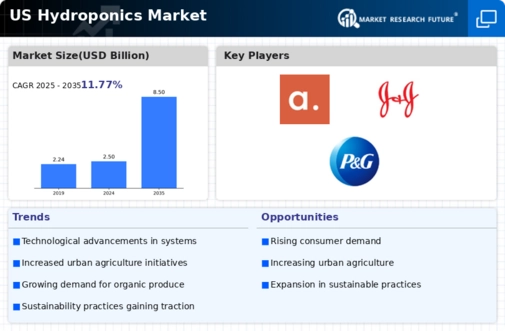Rising Demand for Fresh Produce
The hydroponics market is experiencing a notable increase in demand for fresh produce, driven by consumer preferences for locally sourced and organic food. This trend is particularly pronounced in urban areas, where access to fresh fruits and vegetables can be limited. As a result, hydroponic systems are being adopted by both commercial growers and home gardeners. The market for hydroponics in the US is projected to reach approximately $10 billion by 2026, reflecting a compound annual growth rate (CAGR) of around 25%. This growth is indicative of a broader shift towards sustainable agricultural practices, as consumers become more health-conscious and environmentally aware. The hydroponics market is thus positioned to capitalize on this demand, offering innovative solutions that cater to the evolving preferences of consumers.
Government Support and Incentives
Government initiatives aimed at promoting sustainable agriculture are significantly impacting the hydroponics market. Various federal and state programs offer financial incentives, grants, and subsidies to encourage the adoption of hydroponic systems. These initiatives are designed to support farmers in transitioning to more sustainable practices, thereby enhancing food security and reducing environmental impact. For instance, the USDA has been actively promoting urban agriculture, which includes hydroponics, as a means to improve access to fresh produce in underserved communities. This support not only boosts the hydroponics market but also fosters innovation and research in the field, potentially leading to new developments that could further enhance productivity and sustainability.
Urbanization and Space Constraints
The ongoing trend of urbanization in the US is creating unique challenges for food production, particularly in densely populated areas. As cities expand, available land for traditional agriculture diminishes, leading to a growing interest in hydroponics as a space-efficient solution. Hydroponic systems can be implemented in various settings, including rooftops, basements, and even small backyards, making them ideal for urban environments. The hydroponics market is thus likely to benefit from this trend, as urban dwellers seek innovative ways to grow their own food. This shift not only addresses space constraints but also promotes local food production, contributing to the overall growth of the hydroponics market.
Technological Innovations in Hydroponics
Technological advancements play a crucial role in the hydroponics market, enhancing efficiency and productivity. Innovations such as automated nutrient delivery systems, LED lighting, and advanced monitoring technologies are transforming how hydroponic systems operate. These technologies not only optimize plant growth but also reduce resource consumption, making hydroponics more appealing to growers. The integration of IoT (Internet of Things) in hydroponics allows for real-time data collection and analysis, leading to better decision-making. As these technologies become more accessible, the hydroponics market is likely to see increased adoption rates among both commercial and residential users. This trend suggests a future where hydroponics becomes a mainstream method of food production, further driving market growth.
Increasing Awareness of Water Conservation
Water scarcity is becoming an increasingly pressing issue in the US, prompting a shift towards more efficient agricultural practices. Hydroponics, which uses up to 90% less water than traditional farming methods, is gaining traction as a viable solution. The hydroponics market is well-positioned to address these concerns, as it offers a sustainable alternative that conserves water while maximizing crop yields. As awareness of water conservation grows among consumers and policymakers alike, the demand for hydroponic systems is likely to increase. This trend indicates a potential for significant market expansion, as more growers seek to implement water-efficient practices in response to environmental challenges.














Leave a Comment